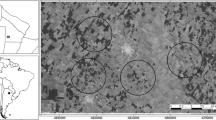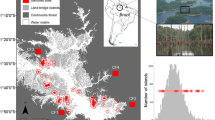Abstract
Unlike many other tropical regions where large-scale habitat loss and habitat fragmentation is a recent phenomenon, deforestation on the island of Java, Indonesia, dates back to the first millennium AD. Today forest remains as numerous isolated patches, covering less than 10 % of the island. This makes it an excellent area to study the effect of forest fragmentation in long-lived animals, such as primates. I surveyed 31 forest fragments, ranging from 1 to 1,300 km2, to assess the primate community composition. Fragments held between one and five species. Excluding the dry easternmost part of the island, there was a significant relationship between species number and fragments size, with a z-value (slope) of 0.20. A nestedness analysis showed the composition of the different fragments to be highly ordered, with smaller fragments comprising subsets of larger ones. True rainforest species, such as the Javan gibbon (Hylobates moloch), are the first species to disappear after isolation. Based on these analyses the minimum fragment size for an area to harbour the entire Javan primate community is between 50 and 400 km2. The close relationship between fragment size, primate number, and rainforest dependence may explain the historic extinction of species, such as the siamang Symphalangus syndactylus and the orang-utan Pongo spp., from Java. With forest disappearing rapidly throughout Southeast Asia the patterns observed on Java allow us one potential view into the future for other regions if forest loss and fragmentation continue along their current trajectory.
Access this chapter
Tax calculation will be finalised at checkout
Purchases are for personal use only
Similar content being viewed by others
References
Atmar W, Patterson BD (1993) The measure of order and disorder in the distribution of species in fragemented habitat. Oecologia 96:373–382
Atmar W, Patterson BD (1995) The nestedness temperature calculator: a visual basic program, including 294 presence-absence matrices [version March 2004]. AICS Research Inc. and The Field Museum, University Park, Chicago, NM
Anonymous (1938) Atlas van tropisch Nederland. Koninklijk Nederlands Aardrijkskundig Genootscha, Amsterdam
Beaufort LF (1926) Zoogeographie van den Indischen Archipel. De Erven F. Bohn, Haarlem
Brook BW, Sodhi NS, Ng PKL (2003) Catastrophic extinctions follow deforestation in Singapore. Nature 424:420–423
Brooks TM, Pimm SL, Collar NJ (1997) Deforestation predicts the number of threatened birds in insular South-east Asia. Conserv Biol 11:382–394
Brooks TM, Pimm SL, Kapos V, Ravilious C (1999a) Threat from deforestation to montane and lowland birds and mammals in insular South-east Asia. J Anim Ecol 68:1061–1078
Brooks TM, Pimm SL, Oyugi JO (1999b) Time lag between deforestation and bird extinction in tropical forest fragments. Conserv Biol 13:1140–1150
Chapman CA, Peres CA (2001) Primate conservation in the new millennium: the role of scientists. Evol Anthropol 10:16–33
Cowlishaw G (1999) Predicting the pattern of decline of African primate diversity: an extinction debt from historical deforestation. Conserv Biol 13:1183–1193
Diamond JM, Bishop KD, Van Balen S (1987) Bird survival in an isolated Javan woodland: Island or mirror? Conserv Biol 1:132–142
Gathorne-Hardy FJ, Syaukani DRG, Eggleton P, Jones DT (2002) Quaternary rainforest refugia in south-east Asia: using termites (Isoptera) as indicators. Biol J Linnean Soc 75:453–466
Geertz C (1960) The religion of Java. University of Chicago Press, Chicago
Geertz C (1963) Agricultural involution: the process of ecological change in Indonesia. University of Chicago Press, Chicago
Harcourt AH (1999) Biogeographic relationships of primates on South-East Asian Islands. Glob Ecol Biogeog 8:55–61
Harrison T, Krigbaum J, Manser J (2006) Primate biogeography and ecology of the Sunda Shelf Islands: a paleontological and zooarcheological perspective. In: Lehman SM, Fleagle JG (eds) Primate biogeography, progress and prospects. Springer, New York, pp 331–372
Heaney LR (1984) Mammalian species richness on islands on the Sunda Shelf, Southeast Asia. Oecologia 61:11–17
Heaney LR (1985) Zoogeographic evidence for Middle and Late Pleistocene land bridges to the Philippine islands. Mod Quat Res SE Asia 9:127–143
Holloway JD, Hall R (1998) SE Asian geology and biogeography: an introduction. In: Hall R, Holloway JD (eds) Biogeography and geological evolution of SE Asia. Backhuys Publishers, Leiden, pp 1–23
Hoogerwerf A, Rengers Hora Siccama GFHW (1938) De avifauna van Batavia en omstreken. Ardea 27(41–92):179–246
Huggett RJ (2004) Fundamentals of biogeography, 2nd edn. Routledge, Abingdon
Koorders SH (1912) Excursion Flora von Java. Fischer, Jena
Kuussaari M, Bommarco R, Heikkinen R, Helm A, Krausse J, Lindborg R, Ockinger E, Pertel M, Pino J, Roda F, Stefanescu C, Teter T, Zobel M, Steffan-Dewenter I (2009) Extinction debt: a challenge for biodiversity conservation. Trends Ecol Evol 24:564–571
Loreau M (2000) Biodiversity and ecosystem functioning: recent theoretical advances. Oikos 91:3–17
MacArthur RW, Wilson EO (1967) The theory of island biogeography. Princeton University Press, Princeton
MacKinnon JR, Smiet F, Artha MB (1982) A national conservation plan for Indonesia, Vol III Java and Bali. Food and Agricultural Organization of the United Nations, Bogor
Meijaard E (2003a) Solving mammalian riddles: a multi-disciplinary reconstruction of the Tertiary and Quaternary distribution and dispersal of selected mammals and their palaeoenvironments in Sundaland and Wallacea. Dissertation, Australian National University
Meijaard E (2003b) Mammals of Southeast Asian islands and their Late Pleistocene environments. J Biogeogr 30:1245–1257
Michalski F, Peres CA (2005) Anthropogenic determinants of primate and carnivore local extinctions in a fragmented forest landscape of southern Amazonia. Biol Conserv 124:383–396
Myers N, Mittermeier RA, Mittermeier CG, Da Fonseca GAB, Kent J (2000) Biodiversity hotspots for conservation priorities. Nature 403:853–858
Nijman V (1997) On the occurrence and distribution of Presbytis comata (Desmarest 1822) (Mammalia: Primates: Cercopthecidae) on Java, Indonesia. Contrib Zool 66:247–256
Nijman V (2000) Geographical distribution of ebony leaf monkey Trachypithecus auratus (Geoffroy Saint Hilaire 1812) (Mammalia: Primates: Cercopthecidae). Contrib Zool 69:157–177
Nijman V (2004) Conservation of the Javan gibbon Hylobates moloch: population estimates, local extinctions, and conservation priorities. Raffles Bull Zool 52:271–280
Nijman V (2006) In-situ and ex-situ status of the Javan gibbon and the role of zoos in conservation of the species. Contrib Zool 75:161–168
Nijman V, Meijaard E (2008) Zoogeography of primates in insular Southeast Asia: species-area relationships and the effects of taxonomy. Contrib Zool 77:117–126
Nijman V, Nekaris KAI (2010) Checkerboard patterns, interspecific competition and extinction: lessons from distribution patterns of tarsiers and slow lorises in insular Southeast Asia. Int J Primatol 31:1147–1160
Preston FW (1960) Time and space and the variation of species. Ecology 41:611–627
BPS (Badan Pusat Statistik) (2004) Population statistics. http://www.bps.go.id/sector/population. Accessed 11 Mar 2004
RePPProT (1990) The land resources of Indonesia: a national overview from the regional and physical planning program for transmigration: plates I-XIV. Land Resources Departement, National Institute Overseas Development Administration and Directorat Bina Program, Directorat Penyiapan Pemukiman, Department Transmigrasi, London and Jakarta
Ricklefs MC (2001) A history of modern Indonesia, since 1200. Stanford University Press, Palo Alto
Smiet AC (1990) Forest ecology on Java: conversion and usage in a historical perspective. J Trop For Sci 2:286–302
Sodhi NS, Koh LP, Brook BW, Ng PKL (2004) Southeast Asian biodiversity: an impending disaster. Trends Ecol Evol 19:654–660
Sodhi NS, Posa MRC, Lee TM, Bickford D, Koh LP, Brook BW (2010) The state and conservation of Southeast Asian biodiversity. Biodivers Conserv 19:317–328
Thorn J, Smith D, Nijman V, Nekaris KAI (2009) Ecological niche modelling as a technique for assessing threats and setting conservation priorities for Asian slow lorises (Primates: Nycticebus). Divers Distrib 15(3):289–298
Van Balen S (1999) Birds on fragmented islands: persistence in the forests of Java and Bali. Dissertation, Wageningen University
Van den Bergh GD, de Vos J, Sondaar PY (2001) The Late Quaternary palaeogeography of mammal evolution in the Indonesian Archipelago. Palaeogeogr, Palaeoclimatol, Palaeoecol 171:385–408
Van Steeniss CGGJ, Schippers-Lammertse AF (1965) Concise plant-geography off Java. In: Backer CA, Bakhuizen van den Brink RC (eds) Flora of Java, vol 2. Noordhoff, Groningen, pp 1–72
Vellend M, Verheyen K, Jacquemyn H, Kolb A, van Kalster H, Peterken G, Hermy M (2006) Extinction debt of forest plants persists for more than a century following habitat fragmentation. Ecology 87:542–548
Wallace AR (1876) The geographical distribution of animals, vol 2. Macmillan, London
Westaway KE, Morwood MJ, Roberts RG, Rokus AD, Zhao JX, Storm P, Aziz F, van den Bergh G, Hadi P, Jatmiko, de Vos J (2007) Age and biostratigraphic significance of the Punung rainforest fauna, East Java, Indonesia, and implications for Pongo and Homo. J Hum Evol 53:709–717
Whitmore TC (1987) Biogeographical evolution of the Malay Archipelago. Clarendon, Oxford
Whitten AJ, Soeriaatmadja RE, Afiff SA (1996) The ecology of Java and Bali, the ecology of Indonesia series vol II. Periplus Editions, Singapore
Wilcox BA (1980) Insular ecology and conservation. In: Soul ME, Wilcox BA (eds) Conservation biology. An evolutionary-ecological perspective. Sinauer, Sunderland, pp 95–117
Acknowledgements
I wish to thank KAI Nekaris for encouragement, LK Marsh for organising the ‘Primates in Fragments Symposium’ at the International Primatological Society Conference in Kyoto, and S van Balen for introducing me to the nestedness programme. My work in Indonesia was made possible due to the collaboration with the Indonesian Institute for Sciences and the Directorate General of Forest Protection and Nature Conservation. Surveys throughout Indonesia were aided by grants from the Netherlands Foundation for International Nature Protection (Van Tienhoven Stichting), Society for the Advancement of Research in the Tropics (Treub Maatschappij), Ape TAG Conservation Initiative, and the University of Amsterdam.
Author information
Authors and Affiliations
Corresponding author
Editor information
Editors and Affiliations
Rights and permissions
Copyright information
© 2013 Springer Science+Business Media New York
About this chapter
Cite this chapter
Nijman, V. (2013). One Hundred Years of Solitude: Effects of Long-Term Forest Fragmentation on the Primate Community of Java, Indonesia. In: Marsh, L., Chapman, C. (eds) Primates in Fragments. Developments in Primatology: Progress and Prospects. Springer, New York, NY. https://doi.org/10.1007/978-1-4614-8839-2_3
Download citation
DOI: https://doi.org/10.1007/978-1-4614-8839-2_3
Publisher Name: Springer, New York, NY
Print ISBN: 978-1-4614-8838-5
Online ISBN: 978-1-4614-8839-2
eBook Packages: Biomedical and Life SciencesBiomedical and Life Sciences (R0)




